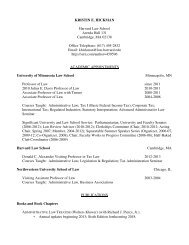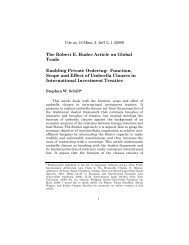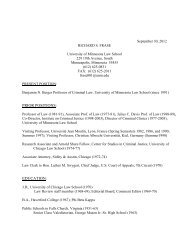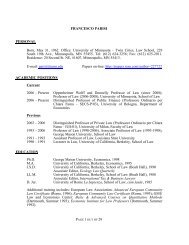The End-of-Life Vehicle (ELV) - the University of Minnesota Law ...
The End-of-Life Vehicle (ELV) - the University of Minnesota Law ...
The End-of-Life Vehicle (ELV) - the University of Minnesota Law ...
You also want an ePaper? Increase the reach of your titles
YUMPU automatically turns print PDFs into web optimized ePapers that Google loves.
2009] END-OF-LIFE VEHICLE DIRECTIVE 445<br />
<strong>the</strong>y remove much <strong>of</strong> <strong>the</strong> incentive for environmentally<br />
beneficial design improvements. 104 A collective duty means that<br />
design improvements that facilitate greater recyclability will not<br />
directly benefit <strong>the</strong> producer who implements those<br />
improvements to <strong>the</strong> exclusion <strong>of</strong> o<strong>the</strong>rs, fur<strong>the</strong>r agitating<br />
producers. 105<br />
Beyond <strong>the</strong> fiscal apprehensions created by <strong>the</strong> <strong>ELV</strong><br />
Directive, <strong>the</strong> lack <strong>of</strong> authority <strong>of</strong> <strong>the</strong> European Commission<br />
creates a potential obstruction to successful implementation. 106<br />
<strong>The</strong> Commission “cannot directly sue facilities within a Member<br />
State, penalize individual facilities, issue compliance or o<strong>the</strong>r<br />
orders directly at regulation entities, or exercise criminal<br />
enforcement authority.” 107 Its only recourse is to institute<br />
infringement proceedings against a Member State. 108 <strong>The</strong>refore,<br />
if a Member State takes a lax approach to <strong>the</strong> implementation <strong>of</strong><br />
<strong>the</strong> <strong>ELV</strong> Directive, <strong>the</strong>re is little that can be done about failures<br />
to meet targets. Fur<strong>the</strong>rmore, <strong>the</strong> automotive industry has<br />
significant power with which to contest <strong>ELV</strong> law<br />
implementation and development. 109<br />
Related to implementation problems is <strong>the</strong> problem <strong>of</strong><br />
information ga<strong>the</strong>ring. <strong>The</strong> Directive provides for a report on<br />
<strong>the</strong> implementation <strong>of</strong> <strong>the</strong> <strong>ELV</strong> Directive to be sent every three<br />
years to <strong>the</strong> Commission. 110 This is problematic for two reasons.<br />
First, much can happen in three years; information that may<br />
have been useful at an earlier date may become moot with <strong>the</strong><br />
passage <strong>of</strong> time. 111 Second, <strong>the</strong> Commission is essentially<br />
104. Sachs, supra note 16, at 77; see also DeWulf et al., supra note 13, at 13.<br />
105. While <strong>the</strong> producer will see a return in <strong>the</strong> form <strong>of</strong> cheaper disposal costs,<br />
its return would be smaller than a rival producer who invests much less in <strong>the</strong><br />
development <strong>of</strong> environmentally beneficial designs. See generally T<strong>of</strong>fel et al., supra<br />
note 21, at 13–15 (discussing how, in a collective responsibility model, reduced costs<br />
will not accumulate exclusively to investing producers). No reasonably prudent<br />
producer would want to subsidize <strong>the</strong> production costs <strong>of</strong> a rival.<br />
106. Rechtschaffen, supra note 96, at 163–64.<br />
107. Id. at 164.<br />
108. Id. Even this authority is fairly weak. <strong>The</strong> Directorate General<br />
Environment only has 450 staff, which could easily be overwhelmed by actions<br />
brought for enforcement <strong>of</strong> a plethora <strong>of</strong> environmental provisions. Id. at 164–65.<br />
Only about ten percent <strong>of</strong> environmental cases are referred to <strong>the</strong> European Court <strong>of</strong><br />
Justice, and citizens cannot challenge decisions not to refer a matter. Id. at 165.<br />
109. See, e.g., Corporate Europe Observatory, Car Industry Flexes its Muscles,<br />
Commission Bows Down, Briefing Paper (Mar. 16, 2007),<br />
http://www.corporateeurope.org/carlobby.html.<br />
110. Council Directive 2000/53/EC, supra note 5, art. 9.<br />
111. On <strong>the</strong> o<strong>the</strong>r hand, <strong>the</strong> three year interval may evince concern for those<br />
countries that do not have <strong>the</strong> resources to commission a report every year.
















